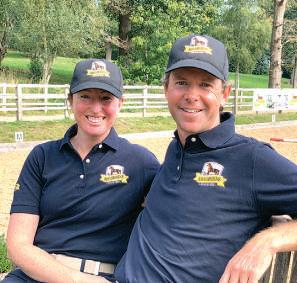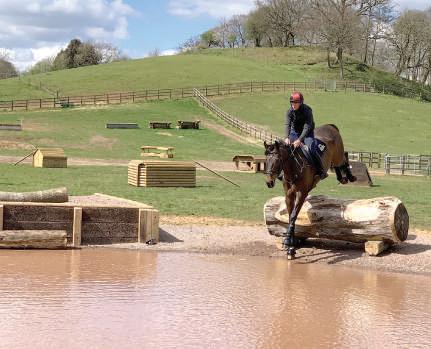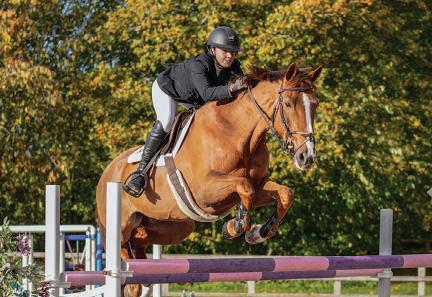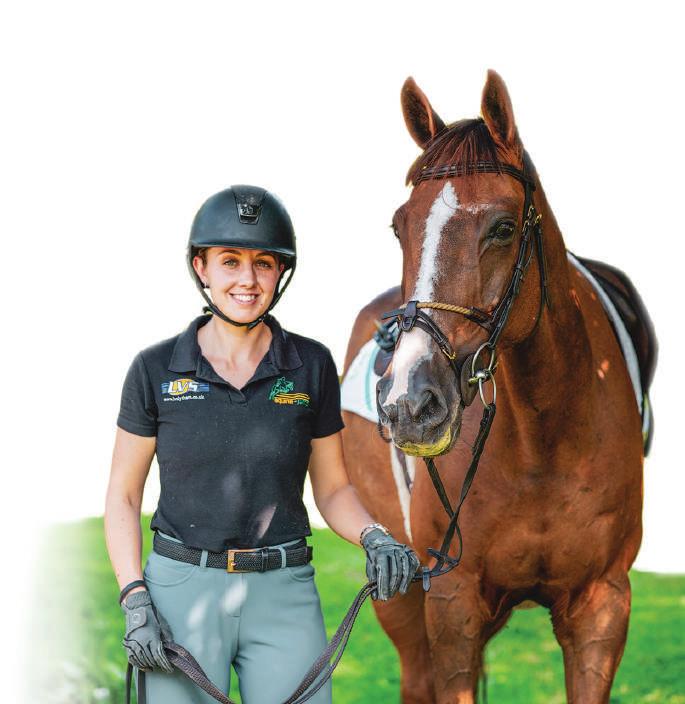
13 minute read
The Professionals - expert hints and tips from Emma and Kevin McNab, Charly Edwards, Jesse and Georgie Campbell
MORE TIPS FROM The Top!

Advertisement


In this issue International event riders Emma and Kevin McNab share their event preparation tips – Part II.
What are your schooling tips to get a horse fit for an event? “The fitness of a horse depends on the level it is competing at. All horses need a good basic level of fitness and we build this up over 8-12 weeks by including a variety of flatwork, jumping, hacking and cantering. Up to novice level we canter our horses once a week but do very little fast galloping work because to compete up to this level they don’t need to do a lot of galloping. “For our horses competing from 3-5* their galloping programs start twelve weeks out from a big event. We will usually gallop them once every four or five days during these twelve weeks. This program begins after 8-12 weeks of basic training.” Do you use hacking/hill work to get your horses fit? “We do both because not only are they good for fitness, but they are also important for the horses’ balance and temperament. We are lucky enough to have a hacking/canter track at our yard and the horses go out on that once a week. “If we worked on a perfectly level surface daily, then went to an event that was on unlevel grassy hills and expected them to have the same balance it would be fair to say this would be very difficult for them. Event horses must have very good foot work and be equipped to perform on sometimes terrible going, so, diversity in training surfaces is key and hacking is great training for this. “Being able to ride out in the
One day a week is dedicated to hacking
IN THIS ISSUE WE CONTINUE OUR SERIES WITH ABSORBINE SPONSORED RIDERS EMMA AND KEVIN MCNAB...
open and not always around the school is very important for a horses’ frame of mind - if you make variety part of the routine their focus will be much better when you get to a show.” Is feeding a consideration? “Absolutely - we adjust the horses feed depending on their
stage of fitness. If their energy levels are too high, we reduce their hard feed or change it to a lower energy feed. Regardless of the adjustments we make sure the horses always have plenty of hay/haylage and grass in the field.” How much jumping, cross country and flat work is done prior to an event and is this scaled back the nearer you get? “Our horses are in full work for at least eight weeks before a competition. They are ridden six days a week. One or two of these days we jump them, one day is dedicated to a hacking/fitness, three or four days to dressage and they have one day off. The level of the horse determines how often we will go crosscountry schooling. “For our older, upper-level horses this might only be once or twice before an event just to refresh everything. For the younger ones who are starting their careers this would be a couple of times each week before competing. “Our program prior to a show depends on each horse and which competition we are going to. For example, when we have a fit horse at a 4/5* event we will school them on the flat twice the day before they do their dressage to make sure their energy level is right for the dressage phase. This is not possible at one-day events as it would mean they would be ridden four times that day! “We like to jump most of our horses two days before a show and then the day before we always do flatwork and run through our dressage test for the next day. “Our aim is for the horses to get to a show with an energy level that they can perform at their best. Usually this means we make sure we do enough work in the week leading up to the show rather than reducing the work. Each horse’s ideal energy level varies but we tend to have quite thoroughbred horses so not having the energy level too high is ideal for them to achieve their maximum output.”
www.absorbine.co.uk
Kevin jump schooling
The level of the horse determines how often the horses go cross-country schooling prior to an event Kevin McNab cross-country trianing at home


Kevin schooling Kevin on the gallops


After a long winter and another lengthy lockdown, it was great to pass the date of 29th March when we were allowed out and about with our horses again!
This time of year is usually super busy for me, both running clinics here at my own yard in Hampshire as well as teaching in other locations. There’s a lot to think about when it comes to planning a clinic – even just choosing a date can be tricky. You have to choose one that doesn’t clash with lots of competitions, or a big event such as Badminton – riders might not be competing there themselves but they will want to stay at home to watch it! With a seasonal sport like eventing, most clinics take place in the weeks running up to the start of the season, rather than in the height of summer when there is a high volume of competitions. Then you have to consider the day of the week, as weekdays might not suit people with full-time jobs, but equally weekends can be super busy too. Plus you can’t start too early in the morning in case people have yard work to finish before they set off. The session times are also important, and you need to make sure that the length of each lesson is going to be adequate for the number of riders taking part. For example, if you just have a couple of people in the lesson then ninety minute sessions would be too long and leave everyone exhausted, but on the other hand giving fortyfive minute to a group of four riders wouldn’t be long enough to give everyone enough attention. For riders, clinics can be an excellent option alongside regular lessons with a trainer. It allows you to get new ideas and insight into your training, you can take part in group lessons which usually means keeping the costs down and being able to watch and learn from other combinations, and you can train with leading riders or trainers who might not be otherwise accessible. It’s also a great way to visit new venues in a low-key situation, with no competition pressure, which can be handy for example if you have a horse who can be spooky or sharp, or if you want to jump a range of different fillers and fences before going out showjumping. When it comes to planning a clinic outing for you and your horse, it does pay to do some

CHARLY EDWARDS IS A SHOWJUMPER BASED IN HAMPSHIRE, WHERE SHE SPECIALISES IN PRODUCING YOUNG SPORT HORSES. SHE NOW RUNS A BUSY YARD THAT OFFERS FULL, COMPETITION AND SALES LIVERY, AS WELL AS ARENA HIRE, CLINICS AND LOCATION HIRE.
CLINIC TIME

research in advance. Some of the best riders aren’t perhaps the best coaches, while others might be great instructors but their teaching style might not suit your needs. So if you are going to a clinic with someone you haven’t trained with before, do some research in advance and see if you can find any recommendations from other riders. When I run clinics, I try to be clear about the set-up of the day so that everyone knows what to expect. Clinic days can be busy with long days of teaching and lots of new faces to remember –I like to have a piece of paper with all the names of each person in each session, as it is a lot of information to remember! I also like to know in advance what sort of level each group is at so that I can plan each session in advance. When signing up for a clinic, try to be honest about your own abilities as you don’t want to be overfaced or equally, not challenged enough. Clinic timings are always carefully planned out but sometimes they do over-run. I always factor in a ten minute gap after each two lessons, to act as a buffer or allow the instructor to have a quick break if things are going to time. It really helps if riders can arrive in plenty of time to get ready and ideally warm-up before their session starts! You can get so much out of a clinic, but do try to bring a positive attitude and keep an open mind to trying new things in your training.
www.charlyedwards equestrian.com Visit any equestrian competition and you’ll see riders and horses exercising carefully in preparation for the challenges ahead, but take a step back and you’ll find that the warmup process poses plenty of questions.
What do riders regard as the benefits of warming up their horse? What is the optimum time for a warm-up? Is there any difference between a showjumping rider’s warm-up and a dressage rider’s warm-up? Does warming up positively affect performance for horse and rider? To help provide some conclusive answers to benefit horse and rider, Associate Professor Dr Jane Williams from Hartpury University and Hartpury graduate Maud Chatel (BSc (Hons) Equine Science), founder and owner of France-based equine therapy company Rehactiv’Equine, carried out a preliminary study involving more than 250 riders. Dr Williams, Head of Research at Hartpury University, said: “To ensure optimal performance, undertaking a warming-up regime before intense exercise is acknowledged as an effective way to lower the risk of injury and increase performance in human athletes. “The same applies to equestrian sport, where it’s widely acknowledged that both the horse and rider should complete a pre-competition warm-up to prepare them for the demands of competition. “The purpose of our study was to try and understand dressage and showjumping riders’ decisionmaking when warming up at home and prior to a competition.” Previous studies have shown that an efficient warmup regime will help to reduce lactic acid accumulation in the muscles, delaying the onset of fatigue and providing a potential performance advantage over horses which have not been warmed up adequately. Before the study by Dr Williams and Ms Chatel, however, few had evaluated what constitutes an ‘ideal’ warm-up for different disciplines, horse experience, training level, fitness or how different environmental factors influence the warm-up. Dr Williams said: “Our study found that dressage and show jumpers maintain that warm-up regimes should prepare the horse for work, increase responsiveness to the riders’ aids, increase the horse’s suppleness and promote relaxation to enhance performance and decrease injury risk. “Interestingly, warm-up duration used was similar for both dressage riders and showjumpers, averaging ten to twenty minutes, though dressage riders used walk as their main warm-up gait, whilst show jumpers preferred trot. “Across both disciplines, riders included technical skills in their warm-up such as lateral work, transitions and jumping. “During a competition, approximately half of dressage and showjumpers surveyed agreed that using the horses’ usual warm-up routine was beneficial.” Ms Chatel, whose business offers sports massage treatments for horses and riders of all levels across France, added: “Riders felt factors such as the stress level of both the horse and rider, crowdedness of the arena, arena size and surface as well as time allocated by the venue were important factors that could impact their warm-up routines. “Both showjumpers and dressage riders considered horses were warmed up adequately using subjective measures likely to vary between riders: the horse’s responsive to the aids, when the horse felt supple and relaxed. “Future research is warranted to investigate if rider recall of warm-up regimes matches the duration and activities included in these, in practice.”


GETTING COMPETITION READY WITH Team Campbell
INTERNATIONAL EVENT RIDERS JESSE AND GEORGIE CAMPBELL HAVE BEEN REGULARS ON THE INTERNATIONAL STAGE FOR THE PAST DECADE. BOTH RIDERS HAVE COMPETED AT THE TOP 5* LEVEL AND REPRESENTED THEIR RESPECTIVE NATIONS (NEW ZEALAND AND GREAT BRITAIN) ON SEVERAL OCCASIONS. SINCE FEBRUARY 2019, THESE TWO WORLD CLASS ATHLETES HAVE JOINED FORCES AND ARE WORKING OUT OF THE SAME BASE AT WOODLANDS FARM IN RAMSBURY, WILTSHIRE. TEAM CAMPBELL IS KINDLY SUPPORTED BY SHIRES EQUESTRIAN, ANTARES, PM EQUESTRIAN, EQUINE AMERICA, KBIS INSURANCE, POINT TWO, PARLANTI BOOTS, STIERNA SPORTSWEAR AND FLEX-ON.
Here at Team Campbell we have been gearing up to the 2021 eventing season throughout the winter months. We are feeling pretty fortunate that our hard work seems to be paying off, as we have got off to a great start with two wins and ten top ten placings from our first two events of the year! Hopefully that won’t jinx us for the rest of the season….
With this in mind, we wanted to give you some insight into getting ready for your first event and some practical event pointers too, to make the day run as smoothly as possible. Preparing for the different phases One thing that’s really key is making sure you and your horse are training really confidently at the level, or even slightly above the level, you are entered for. With the dressage phase, we will always make sure the younger horses have had a practice in a grass arena with boards before their first competition. If you have been schooling all winter in a fenced, surfaced area, a 20x40m can feel very small. We also find it beneficial to get them use to white boards as well as working in an open space with no sides or fence holding them in. We sometimes add in a flower pot or two around the arena too, so they don’t throw in a spook just as you are about to go down the centre line at a competition! For the showjumping, it is great if you can get out to a few local showjumping competitions before going to an event. This gets them use to a variety of fillers, and also to busy warm-up arenas, which can unsettle some young or novice horses. With the cross-country phase, we will also head out schooling to several venues, to get them going and confident with various different obstacles, such as the water jump and ditches. We will also make sure to link several fences together, to make sure the control is there and the horses are adjustable to a fence after being moved up a gear. Prepare to suceed There are a few stable management things that can be helpful to practice at home, precompetition, so on the day there aren’t any additional surprises or pressure. Firstly, have a go at plaiting up your horse. You can then see how long it will take, how they behave to be plaited, and it also gets them use to having plaits in. Same goes with studs, there is nothing worse that trying to stud up a very excited horse for the first time at a competition when you’re under time pressure. Make sure the stud holes are really well cleaned out before you leave and you have all the kit you need. Another thing to check is that your horse will stand on the










